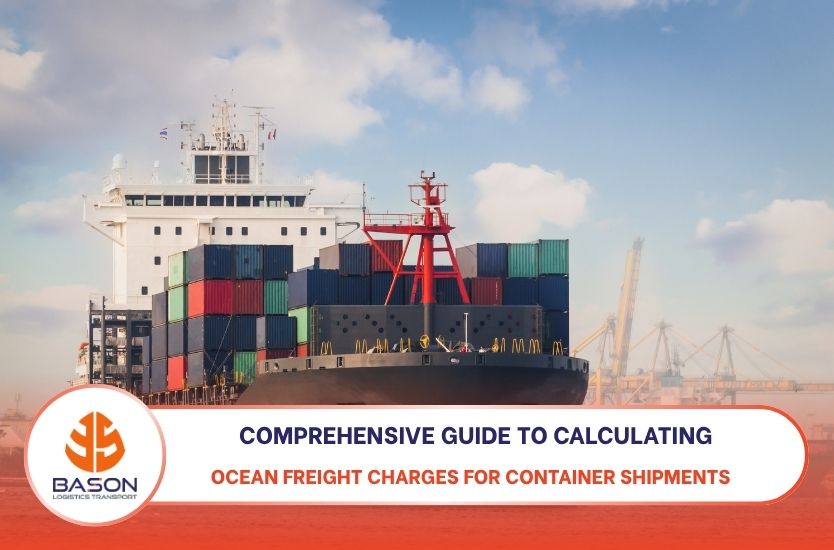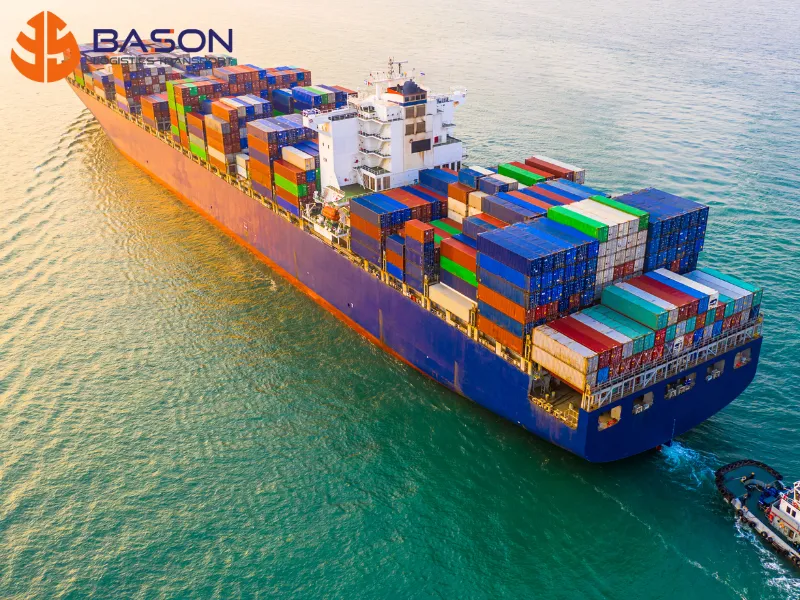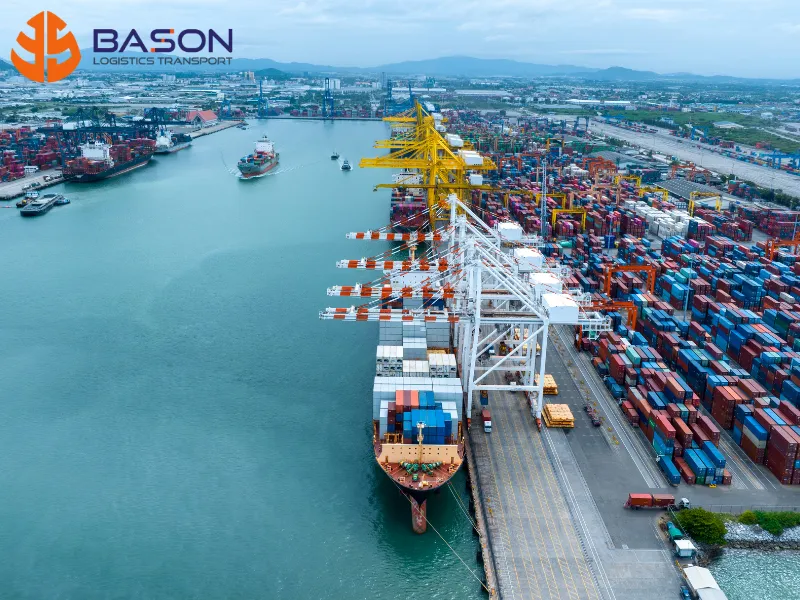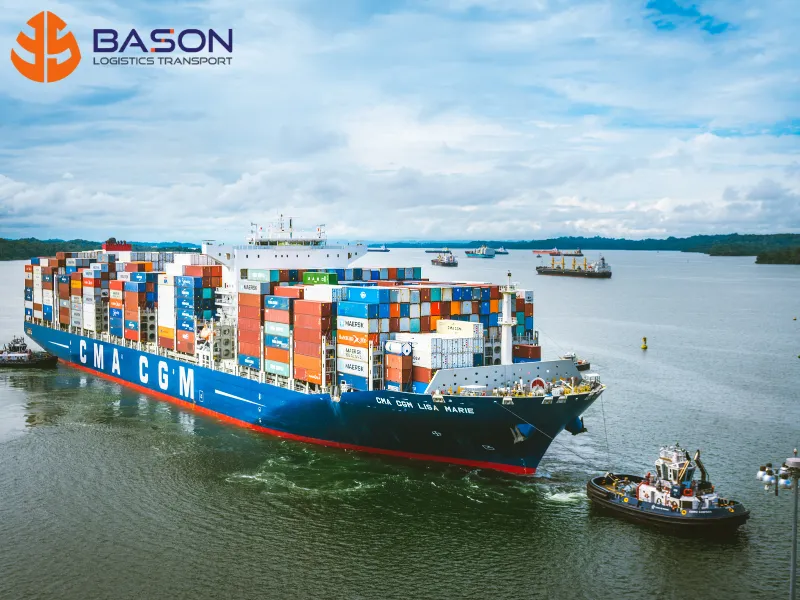
Understanding how ocean freight rates are calculated helps businesses take control of their logistics costs and choose the most efficient shipping routes. Here's a detailed guide from Bason to help you stay ahead.
The basic structure of an ocean freight rate sheet
Base freight rates by container type
In ocean freight, shipping costs are calculated based on the type of container used.
For full container loads (FCL), the rate is determined by container size—typically 20-foot (20DC), standard 40-foot (40DC), or high-cube 40-foot (40HC). This option is ideal for bulk, uniform cargo, allowing businesses to optimize cost per unit.
For less-than-container loads (LCL), charges are based on either volume (CBM) or weight (kg), depending on which is greater. This method is commonly used by smaller exporters or businesses shipping samples, as it helps reduce initial logistics expenses.
Distinguishing between local charges and international freight charges
A typical ocean freight rate sheet usually includes two main cost components:
First is the international freight charge (ocean freight) – covering the cost from the port of departure to the port of arrival, as listed by the shipping line.
Second are the local charges at both origin and destination ports, including: Terminal Handling Charges (THC), Container Imbalance Charge (CIC), Documentation Fee (DOC), Security Surcharge (ISPS), Automated Manifest System (AMS), and other surcharges such as Bunker Adjustment Factor (BAF), Peak Season Surcharge (PSS), war risk surcharge, and transshipment fees.
Clearly understanding the pricing structure is essential for accurately calculating ocean freight costs and avoiding unexpected charges during payment or delivery.

Factors affecting how ocean freight rates are calculated
Shipping routes and market conditions
Ocean freight rates vary significantly by route—whether it's from Asia to the U.S., Asia to the EU, or within Vietnam's domestic network. Longer routes or those passing through sensitive maritime zones like the Red Sea or the Suez Canal typically incur higher base rates and surcharges due to added risks, fuel costs, and security concerns.
Additionally, container or vessel shortages during peak seasons can cause sudden spikes in freight rates within a short period, as demand exceeds available capacity.
Cargo type and transport conditions
Freight rates also vary significantly depending on the nature of the cargo. Dangerous goods (DG), temperature-sensitive shipments (reefer), oversized cargo, or items requiring special packaging often incur additional charges.
Moreover, specific requirements such as palletization, labeling, or customs inspection handling must be quoted separately and factored into the logistics budget in advance.
Delivery terms under Incoterms
Choosing Incoterm like EXW, FOB, CIF, or DAP is not just a legal matter—it also determines which party bears which portion of the shipping costs. For example, under FOB terms, the buyer is responsible for all charges from the port of origin to the final destination, including domestic transportation.
Conversely, CIF terms include both ocean freight and insurance in the price of goods, so it’s essential to calculate carefully to avoid cost overlap or omissions during budgeting.

Steps businesses should take to calculate ocean freight costs accurately
Step 1 – Identify cargo type, dimensions, and actual weight
Before requesting a freight quote, businesses need to clearly identify the cargo specifications.
For LCL shipments, the CBM is calculated using the formula: (Length × Width × Height)/1,000,000 (in millimeters). Then, compare the actual weight with the chargeable weight (CBM multiplied by a route-specific conversion factor, e.g., 1 CBM = 500–1000 kg) to determine the billable amount.
For FCL, it's important to specify the container type and evaluate whether the available volume is fully utilized to optimize cost per unit shipped.
Step 2 – Request quotes from reputable forwarders or carriers
When asking for quotes, businesses should request a clear breakdown between ocean freight and local charges. It’s important to verify whether surcharges such as AMS, D/O, container cleaning, or war risk fees are included. If the quoted price seems unusually low, question the quality of service, vessel schedule reliability, and how much responsibility the provider takes in case of unexpected issues.
Step 3 – Review payment terms, sailing schedule, and possible surcharges
Finally, reviewing payment terms (e.g., pre-payment or post-loading), container free time, and detailed sailing schedules is essential. Unexpected costs such as last-mile delivery fees, container detention charges, or inspection-related surcharges can significantly increase the total cost if not accounted for in advance.

Common mistakes businesses make when calculating ocean freight costs
Only looking at freight rates while ignoring local charges
One of the most common mistakes in logistics cost planning is focusing solely on the main freight charge—while overlooking local charges. This can cause the actual total cost to be much higher than expected, especially when extra fees like D/O (Delivery Order), handling, container cleaning, CIC, AMS, or THC are involved.
Missing these components not only disrupts budgeting but can also delay cargo release if there isn’t enough funding prepared in advance.
Failing to align Incoterms when sharing cost responsibilities
When using FOB terms, the buyer is responsible for all costs from the port of departure to the final destination. However, many businesses fail to clearly define responsibilities under Incoterms, leading to duplicate charges or costs that should have been covered by the partner.
For example, if a supplier provides a quote under FOB terms but still adds origin THC or D/O fees, those charges may be redundant and unnecessarily inflate the total cost.
Lack of clear contracts – prone to disputes
Another common mistake is failing to clearly define surcharges related to peak seasons or schedule changes in the shipping contract. In reality, vessel delays, transshipments, or unexpected Peak Season Surcharges (PSS) can occur. Without written agreements outlining who bears these costs, businesses may be forced to pay extra fees without any basis for dispute or claim.
Bason – Your trusted partner for transparent and flexible ocean freight cost planning
A transparent and well-structured quoting system
Bason Bason doesn’t offer generic “all-in-one” quotes—instead, we provide clearly itemized pricing based on key factors like container type, shipping route, surcharges, and timing. All quotes are updated in real time to reflect vessel schedules and market conditions, helping businesses track and control costs with confidence.
For LCL shipments, Bason also supports cargo consolidation from multiple factories and calculates volume, weight, and applicable surcharges with precision—especially valuable for companies with decentralized production systems.
Integrated services: Stuffing – transport – warehousing
Beyond cost calculation, Bason offers end-to-end solutions including cargo consolidation, container stuffing, transportation, and delivery. With a network of bonded warehouses, transit hubs, and inland trucking services, Bason helps shorten the time from factory to port while minimizing costs related to container detention, customs inspection, or schedule changes.
In a context where global shipping rates fluctuate constantly, understanding how ocean freight is calculated empowers businesses not only to forecast costs accurately but also to strengthen contract negotiations, allocate responsibilities properly, and plan operations efficiently.
There’s no universal pricing formula for every shipping lane, but mastering the cost structure and partnering with a capable logistics provider like Bason is the key to avoiding common pitfalls—and turning logistics from a burden into a long-term competitive edge.
Contact:
- Address: M Floor, 104 Bat Nan Street, Binh Trung Ward, Ho Chi Minh City, Vietnam
- Email: sales@bason.vn
- Hotline: 0869 456 077

